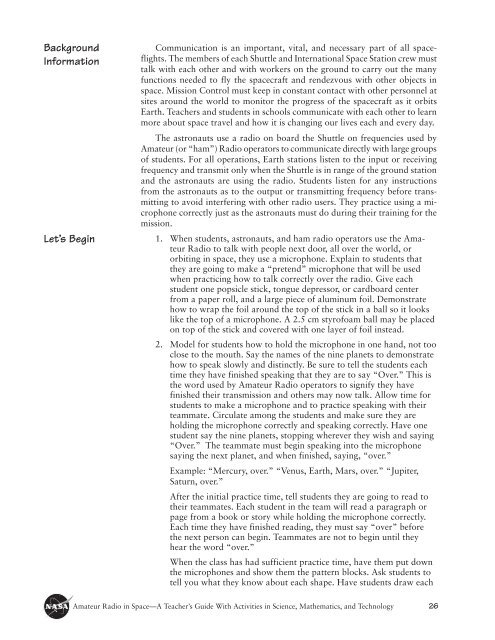Amateur Radio in Space - ER - NASA
Amateur Radio in Space - ER - NASA
Amateur Radio in Space - ER - NASA
- No tags were found...
You also want an ePaper? Increase the reach of your titles
YUMPU automatically turns print PDFs into web optimized ePapers that Google loves.
BackgroundInformationLet’s Beg<strong>in</strong>Communication is an important, vital, and necessary part of all spaceflights.The members of each Shuttle and International <strong>Space</strong> Station crew musttalk with each other and with workers on the ground to carry out the manyfunctions needed to fly the spacecraft and rendezvous with other objects <strong>in</strong>space. Mission Control must keep <strong>in</strong> constant contact with other personnel atsites around the world to monitor the progress of the spacecraft as it orbitsEarth. Teachers and students <strong>in</strong> schools communicate with each other to learnmore about space travel and how it is chang<strong>in</strong>g our lives each and every day.The astronauts use a radio on board the Shuttle on frequencies used by<strong>Amateur</strong> (or “ham”) <strong>Radio</strong> operators to communicate directly with large groupsof students. For all operations, Earth stations listen to the <strong>in</strong>put or receiv<strong>in</strong>gfrequency and transmit only when the Shuttle is <strong>in</strong> range of the ground stationand the astronauts are us<strong>in</strong>g the radio. Students listen for any <strong>in</strong>structionsfrom the astronauts as to the output or transmitt<strong>in</strong>g frequency before transmitt<strong>in</strong>gto avoid <strong>in</strong>terfer<strong>in</strong>g with other radio users. They practice us<strong>in</strong>g a microphonecorrectly just as the astronauts must do dur<strong>in</strong>g their tra<strong>in</strong><strong>in</strong>g for themission.1. When students, astronauts, and ham radio operators use the <strong>Amateur</strong><strong>Radio</strong> to talk with people next door, all over the world, ororbit<strong>in</strong>g <strong>in</strong> space, they use a microphone. Expla<strong>in</strong> to students thatthey are go<strong>in</strong>g to make a “pretend” microphone that will be usedwhen practic<strong>in</strong>g how to talk correctly over the radio. Give eachstudent one popsicle stick, tongue depressor, or cardboard centerfrom a paper roll, and a large piece of alum<strong>in</strong>um foil. Demonstratehow to wrap the foil around the top of the stick <strong>in</strong> a ball so it lookslike the top of a microphone. A 2.5 cm styrofoam ball may be placedon top of the stick and covered with one layer of foil <strong>in</strong>stead.2. Model for students how to hold the microphone <strong>in</strong> one hand, not tooclose to the mouth. Say the names of the n<strong>in</strong>e planets to demonstratehow to speak slowly and dist<strong>in</strong>ctly. Be sure to tell the students eachtime they have f<strong>in</strong>ished speak<strong>in</strong>g that they are to say “Over.” This isthe word used by <strong>Amateur</strong> <strong>Radio</strong> operators to signify they havef<strong>in</strong>ished their transmission and others may now talk. Allow time forstudents to make a microphone and to practice speak<strong>in</strong>g with theirteammate. Circulate among the students and make sure they arehold<strong>in</strong>g the microphone correctly and speak<strong>in</strong>g correctly. Have onestudent say the n<strong>in</strong>e planets, stopp<strong>in</strong>g wherever they wish and say<strong>in</strong>g“Over.” The teammate must beg<strong>in</strong> speak<strong>in</strong>g <strong>in</strong>to the microphonesay<strong>in</strong>g the next planet, and when f<strong>in</strong>ished, say<strong>in</strong>g, “over.”Example: “Mercury, over.” “Venus, Earth, Mars, over.” “Jupiter,Saturn, over.”After the <strong>in</strong>itial practice time, tell students they are go<strong>in</strong>g to read totheir teammates. Each student <strong>in</strong> the team will read a paragraph orpage from a book or story while hold<strong>in</strong>g the microphone correctly.Each time they have f<strong>in</strong>ished read<strong>in</strong>g, they must say “over” beforethe next person can beg<strong>in</strong>. Teammates are not to beg<strong>in</strong> until theyhear the word “over.”When the class has had sufficient practice time, have them put downthe microphones and show them the pattern blocks. Ask students totell you what they know about each shape. Have students draw each<strong>Amateur</strong> <strong>Radio</strong> <strong>in</strong> <strong>Space</strong>—A Teacher’s Guide With Activities <strong>in</strong> Science, Mathematics, and Technology 26
















